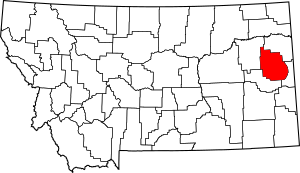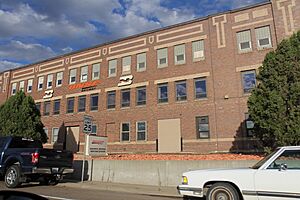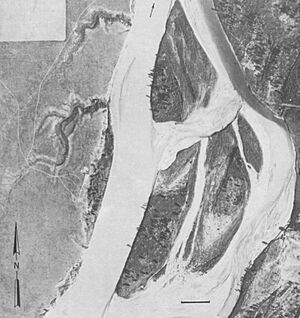National Register of Historic Places listings in Dawson County, Montana facts for kids
Have you ever wondered how we protect old buildings and special places? In Dawson County, Montana, there's a list of important spots called the National Register of Historic Places. This list helps keep track of buildings, bridges, and even ancient sites that are really important to the history of Montana and the United States.
When a place is on this list, it means it's recognized as special and worth preserving for future generations. Dawson County has 13 places on this list, and one of them is even a National Historic Landmark – that's a super important kind of historic place!
Contents
Discovering Dawson County's Historic Treasures
Dawson County is home to many places that tell stories from the past. These sites are protected because they show us how people lived, worked, and built things long ago. Let's explore some of these amazing historic spots.
Important Buildings and Bridges
Many of the places on the list are buildings and bridges in and around Glendive, the county seat. These structures often show the architecture and engineering of their time.
Old Bridges Connecting Communities
- Bad Route Creek Bridge: This bridge, built between 1900 and 1958, is a great example of early concrete bridges in Montana. It's located near Fallon and shows how people used to build strong crossings over creeks.
- Bell Street Bridge: Found in Glendive, this bridge is another important piece of local history. Bridges like these were vital for travel and trade, helping communities grow.
Historic Homes and Churches
- Blackstock Residence: This old house in Glendive gives us a peek into how homes were designed and built many years ago.
- First Methodist Episcopal Church and Parsonage: This church and its nearby parsonage (the minister's house) in Glendive show us the religious and community life of the past.
- Charles Krug House: Located in Glendive, this house is another example of the unique architecture from a different era.
- McCone Residence: Another historic home in Glendive, adding to the collection of preserved residential buildings.
- Sacred Heart Church: This church in Glendive is also on the list, highlighting its importance to the community's history and faith.
Glendive's Early Infrastructure
- Glendive City Water Filtration Plant: This plant shows how Glendive provided clean water to its residents long ago. It's a reminder of how cities developed important services.
- Glendive Heat, Light and Power Company Power Plant: This power plant was crucial for bringing electricity and heat to Glendive, changing daily life for its citizens.
- Northern Pacific Railroad Settling Tanks: These tanks were part of the railroad system, which played a huge role in the growth of Montana. They helped the trains run smoothly.
- US Post Office: The old post office building in Glendive is also recognized. Post offices were central hubs for communication and community gathering.
Merrill Avenue Historic District
The Merrill Avenue Historic District in Glendive is not just one building, but a whole area! It includes many historic buildings along Merrill Avenue. Walking through this district is like taking a step back in time, seeing how a main street looked and functioned decades ago. It's a great example of how entire neighborhoods can be preserved for their historical value.
The Hagen Site: A National Historic Landmark
The most important site on the list in Dawson County is the Hagen Site. This isn't a building, but an archaeological site. It's so important that it's been named a National Historic Landmark. This means it has special national importance, often related to ancient cultures or significant events. Archaeological sites like the Hagen Site can teach us a lot about the very first people who lived in this area.
Why Are These Places Important?
These historic places in Dawson County are like puzzle pieces that help us understand the past. They show us how people lived, what kind of buildings they constructed, and how communities like Glendive grew. Protecting them means we can continue to learn from history and appreciate the efforts of those who came before us.




